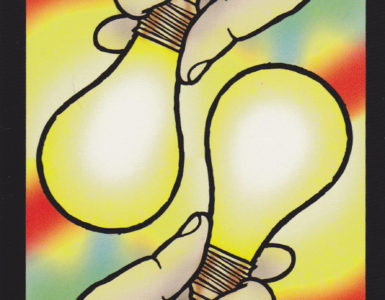 I have a tendency to hop on bandwagons. I’m especially prone to what I call “Latest Book Syndrome” — picking up ideas from the latest book I’ve read and passionately advocating them. It’s my way of seeing if ideas have “legs.”
I have a tendency to hop on bandwagons. I’m especially prone to what I call “Latest Book Syndrome” — picking up ideas from the latest book I’ve read and passionately advocating them. It’s my way of seeing if ideas have “legs.”
Not long ago, a MadeByMark.com reader recommended that I read Byron Katie’s Loving What Is. The book’s basic message is simple: the root of most stress and grief is our rejection of reality in favor of “what ought to be true” or “what other people should do.” Want to live a less stressful life? Set your elaborate stories aside, get in touch with reality, and learn to love what is.
I added the book to my Amazon.com wish list, but never ordered it. And then, while browsing books at New Vibrations, this compact title almost literally jumped off the shelf and into my hands. I bought it, read it, tried some of Byron Katie’s techniques … and experienced results that amazed me.
That was four months ago. I wanted to tell you about the book back then … but hesitated. Instead of merely jumping on the band wagon, I wanted to see if these techniques had staying power. Could the book’s four questions really “change your life?” Would they prove useful over time? Would they “have legs?” Would I still be using Byron Katie’s techniques — what she calls The Work — four months later?
Here’s my verdict.
I’ve got a few books on my shelf that can lay claim to being life-changing. To earn that claim, they have to become a part of the way I think and act on an almost daily basis.
– Reading Blake Snyder’s Save the Cat altered forever the way I experience and analyze movies, television shows, and books. That’s life-changing.
– David Allen’s concepts (particularly “next actions” and contexts for To Do lists — part of his Getting Things Done system) make me more productive almost every day. That’s life changing.
– Richard Dawkins’ The Blind Watchmaker swept away the lies I’d been taught about evolution and helped me see some of the logical pitfalls of fundamentalism. That’s life changing.
– The War of Art, a short book by Steven Pressfield, still pops into my head every time resistance threatens to blunt my progress toward my dreams. That’s life changing.
I’m happy to report that Byron Katie’s Loving What Is is also a life-changing book.
The core concept — letting go of unreasonable expectation and irrational desire as a means of achieving peace — is as old as Buddha. But Byron Katie’s four questions (and, especially, the worksheet used to explore and articulate your answers) are simple, effective tools that can, in minutes, yield insights that take years of meditation (or therapy) to achieve otherwise.
After reading the book for the first time, I decided to apply the process — what Byron Katie calls “The Work” — as a means of dealing with an old, deep wound — a broken friendship — that has haunted me for years. “That person shouldn’t have treated me that way!” (He did treat me that way — and I stuck around for it.) “That person should haven’t have said the things he did!” (He did say those things — and I let him.) “That person shouldn’t have ended our friendship without an explanation!” (He did exactly that, and then moved on — and I didn’t).
It took me about thirty minutes to receive an insight I hadn’t achieved in twenty years: it was time to quit thinking about what should have happened and embrace what really happened … and why. And I can honestly say that, since completing that exercise, that particular demon has not once — not even once — come knocking at my mental door.
Over the past four months, The Work has come in handy again and again:
– My mother should give me unconditional love. (Is that true? Is that really, objectively true? How do I feel when I believe that thought? What kind of person would I be without it?)
– My books should be selling better than they are. (Is that true? Is that really, objectively true? They’re selling as they’re selling — that’s reality. What might happen if you put aside the idea that you books should sell a certain amount … and devoted that energy to creating other books?)
– I should be living in Atlanta. (Is that true? Are you living in Atlanta? No? Then the reality is that you live in Jackson. If you’re not at home with that reality, maybe you should dedicate yourself to closing the gap between where you are now … and where you want to be.)
In short, these questions have done more than stick with me … they’ve become part of how I see the world. That’s not saying I’ve become a Buddha (though, admittedly, I am built a bit like those Happy Buddhas from China) … but I am saner, less stressed, and more in tune with reality than ever.
And I still have a lot of growing to do. I still let the occasional little thing set my blood to boiling. But I’m more likely than ever to hear myself saying “So and so should do this…” — and now, when I hear that, I stop, breathe, and do The Work.
Loving What Is explains the principles in plain English and gives you simple, step-by-step instructions for achieving this change in your own life. I can’t recommend it enough.





Add comment